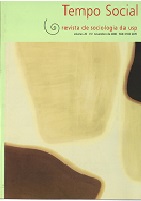Pathways of the sacred
DOI:
https://doi.org/10.1590/S0103-20702008000200006Keywords:
Religious Pluralism, Religious Trajectories, Religious Duplicity, Individual ReligionAbstract
The aim of this article is to analyze the current dynamic of the São Paulo religious field, seen not through the plurality of its religious organizations, nor through the positions adopted by ecclesiastical or group leaders. Instead, I focus on the individual religious agents and their attitudes in response to a growing religious pluralism and diversification. The work therefore looks at individuals who are 'religious mutants:' people who have changed their religious affiliation at least once during their lives, or who are religious duplicates or multiplicates, participants of two or more symbolic-religious universes simultaneously. By studying people's religious trajectories, we can analyze their beliefs and religious practices irrespective of their affiliation to specific organized groups. With the single exception of the Protestants, still anchored in the conception of a transcendent God and a strong ecclesiality (though the Pentecostals diverge slightly through their incorporation of magic), we can perceive a trend towards a kind of religiosity that Troeltsch called mystic - and which Campbell identifies as its orientalization. The followers of other religions, or the duplicates/multiplicates, tend towards mystical religious ideas and magical practices lived out in private, accept frequenting a variety of religious groups and repudiate clerical authoritarianism. The old conflicts of traditional religious duplicities (Catholicism/Spiritism; Catholicism/Afro-Brazilian Religions) have been amplified with new forms (Catholic/Protestant; Catholic/Other Religions) and with the emergence of multiplicity, reproducing in Brazilian style the same transformations experienced throughout the West for a long time.Downloads
References
BOURDIEU, Pierre. (1974), “Gênese e estrutura do campo religioso”. In: A economia das trocas simbólicas. São Paulo, Perspectiva, pp. 27-69.
CAMPBELL, Colin. (1997), “A orientalização do Ocidente: reflexões sobre uma nova teodicéia para um novo milênio”. Religião e Sociedade, 18 (1).
FOLHA DE S. PAULO. (2007), Caderno Religião, 6/5.
GALVÃO, Walnice Nogueira. (2001), O império do Belo Monte: vida e morte de Canudos. São Paulo, Fundação Perseu Abramo.
HOORNAERT, Eduardo. (1974), Formação do catolicismo brasileiro, 1550-1800. Petrópolis, Vozes.
HOORNAERT, Eduardo. (org.). (1977), História da Igreja no Brasil, tomo 2. Petrópolis, Vozes.
IBGE. (1991), Censo demográfico brasileiro de 1991.
HOORNAERT, Eduardo. (2000), “Tendências demográficas: uma análise com base nos resultados dos censos de 1940 e 2000”. Estudos e Pesquisas, n. 20.
MONTEIRO, Duglas Teixeira. (1974), Os errantes do novo século: um estudo sobre o surto milenarista do Contestado. São Paulo, Duas Cidades.
OLIVEIRA, Pedro Ribeiro de. (1976), “Catolicismo popular e romanização do catolicismo brasileiro”. Revista Eclesiástica Brasileira, 36 (141).
QUEIROZ, Maria Isaura Pereira de. (1973), “O catolicismo rústico no Brasil”. In: O campesinato brasileiro: ensaios sobre civilização e grupos rústicos no Brasil. Petrópolis, Vozes.
RIBEIRO, Boanerges. (1973), Protestantismo no Brasil monárquico. São Paulo, Pioneira TROELTSCH, Ernst. (1958), Protestantism and progress: a historical study of the relation of protestantism to the modern world. 1ª edição 1907. Londres, Beacon Press.
Downloads
Published
Issue
Section
License
Copyright (c) 2015 Tempo Social

This work is licensed under a Creative Commons Attribution-NonCommercial 4.0 International License.


